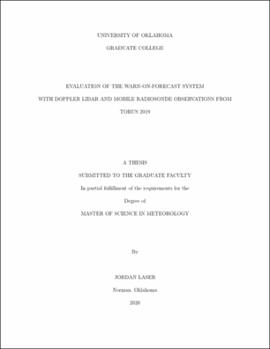| dc.description.abstract | Doppler lidar and mobile radiosonde observations from the Targeted Observations with
Radars and UAS of Supercells 2019 (TORUS2019) eld project are compared to the environ-
mental guidance NSSL Warn-on-Forecast System (WoFS). The aim of WoFS is to provide
short-term, storm-scale, probabilistic guidance for severe thunderstorm hazards. As the
evolution of convective storms is modulated by the properties of the in
ow environment,
an accurate prediction of these properties is important for forecasting the evolution of an
individual thunderstorm. However, the scarcity of routine observations of the in
ow envi-
ronment of thunderstorms makes evaluation of the quality of WoFS environmental forecasts
di cult. Therefore, this study will assess the accuracy of WoFS predictions of the in
ow
environment of supercells through comparisons to TORUS2019 Doppler lidar and radiosonde
observations.
Three case studies from TORUS2019 are explored to evaluate WoFS forecasts: 17 May,
20 May, and 23 May. 16 radiosonde observations and 5 lidar deployments are available for
comparison during WoFS forecasts. All 16 radiosondes made it above 3 km so SRH compar-
isons can be made with all. However only 5 radiosondes traveled high enough (equilibrium
level, EL) to compute CAPE, a testament to the tumultuous environment in which they
were released. Five lidar deployments are analyzed, three of which are 1 hour long. Three
out of four observed supercells on these days produced a tornado within 1 hour and 40 km
of a lidar deployment.
WoFS over forecasted mixed-layer and surface based convective available potential en-
ergy (MLCAPE and SBCAPE) in all 5 radiosonde observations available for comparison,
owing largely to positive surface temperature error and negative temperature error above
the plentary boundary layer(PBL). The YSU (PBL) scheme consistently forecasted lower
CAPE and thus had the lowest error. Similarly, YSU often forecasted lower storm-relative
helicity (SRH), a common trend as Cohen et al. (2015) and (2017) found. SRH comparisons
show WoFS typically under forecasting SRH at later times in the evening on 17 May and
23rd, owing to di erences in storm motion and more backing in the observation. WoFS well
forecasts SRH on 20 May, with small negative errors in YSU and MYJ; The observation falls
within the 50th percentile of MYNN for 4 out of 6 observations.
The lidar deployments show WoFS modifying the near-storm environment as the storm
approaches similarly to that of the observation, except when the intensity of the mesocyclone
is variable. Following a drop in rotational velocity of the mesocyclone, WoFS backs the winds
during the rst deployment on 20 May, however the observations do not back, likely as a
response to the variable mesocyclone intensity. The lidar deployment on 17 May observed
a supercell with constant rotational velocity and WoFS forecasts backing of the winds, but
not to the same extent as in the observation. | en_US |
